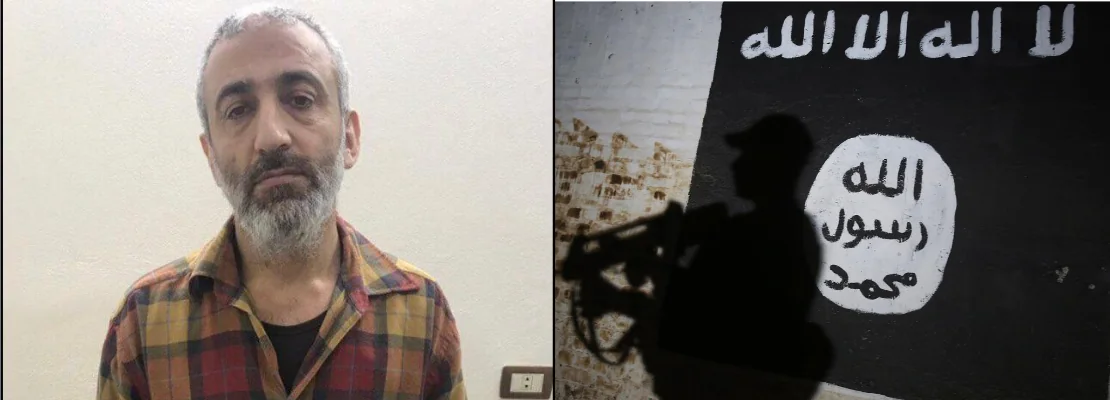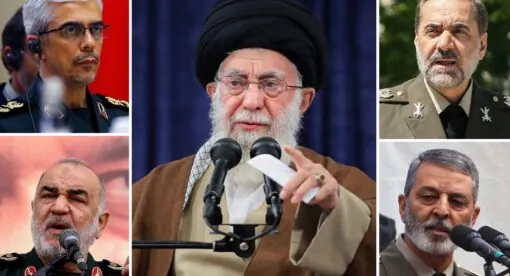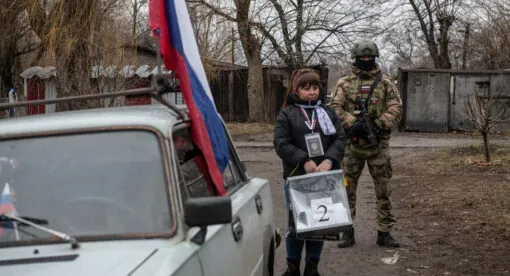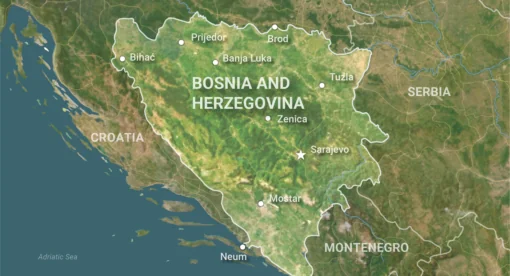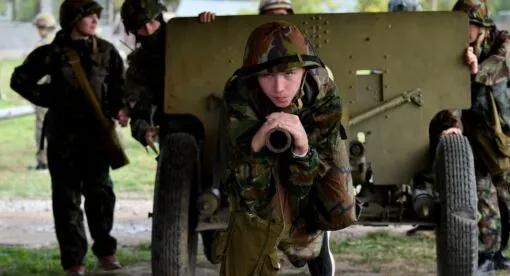Editor’s Note: This interview is part eight of “ISIS 2020” – a series of briefings about the current status of the Islamic State by authors from different parts of the region. It is based on a conversation that our Nonresident Fellow Dr. Husham al-Hashimi had with Abdul Nasser Qardash, the highest-ranking ISIS leader incarcerated in Iraq.
It is published by the Newlines Institute’s Nonstate Actors program. Parts one, two, three, four, five, six, and seven were released on April 28, May 5, May 12, May 19, May 26, and June 2, respectively.
Background
In mid-May, Iraqi security forces announced that they captured a senior ISIS leader. His name is Tahah Abdel Rahim Abdallah Bakr al-Ghassani, known within the Islamic State (ISIS, ISIL, or Daesh) as Hajji Abdul Nasser Qardash and is also called Abu Muhammad, Abu Abdel-Rahman al-Shami, or Abu Abdel-Rahim. He was born in 1967 in Tal Afar and lived in the Musharafah neighborhood in Mosul. He was active in the Ansar al-Islam movement in Iraq in 2003 but was arrested by U.S. forces in 2005. After being released in 2007, he pledged allegiance to the Islamic State of Iraq (usually known as al Qaeda in Iraq), and in 2011 he was introduced to ISIS’s former leader and caliph, Abu Bakr al-Baghdadi. Qardash supposedly had a significant hand in forming ISIS: After numerous interviews with al-Baghdadi, he planted the idea of uniting the two branches of the group in Syria and Iraq.
In 2014, he held the position of the wali (governor) of al-Barakah (ISIS’s name for Hasakah), and, after the declaration of the caliphate, he was assigned the position of deputy amir of the Delegated Committee and then amir of the Committee. Although he was reportedly punished for questioning al-Baghdadi’s decisions, he nonetheless became a supervisor of development and manufacturing until 2017, and, after the killing of ISIS spokesman Abu Muhammad al-Adnani, he became both the Delegated Committee’s amir and al-Baghdadi’s deputy until 2019.
The author sat with Qardash from 11 a.m. to 3 p.m. on May 17, 2020, and spoke with Qardash about his perspective on ISIS’s formation, financial structure, organizational structure, and ideology. All the direct quotes within this interview are from Qardash.
As is the case with other interviews with jailed ISIS fighters, Qardash’s claims should be taken with a grain of salt. But the author has conducted countless interviews with members of the organization and, while they may contain half-truths, outright lies and misleading details, many of these interviews often contain tactical details that have in the past proven to be accurate. The author is confident that the details are valuable from a counterterrorism/counterinsurgency perspective and can enhance readers’ understanding of the group and its worldview. Separately, when asked by CGP, the group’s rivals in Syria corroborated some of the details, especially regarding events that happened there.
The Rise of ISIS
According to Qardash, ISIS thrived in the western Iraqi and eastern Syrian border region due to anti-government sentiment in Syria and Iraq, and specifically sentiments among Iraqis against their country’s Prime Minister Nouri al-Maliki. Qardash said in the interview that these trends coincided with the release from prison of long-standing Iraqi jihadist ideologue Abu Ala al-Afri (Abdulrahman Mustafa al-Qaduli, formerly a member of al Qaeda and the Islamic State in Iraq before the group became ISIS; he was killed on March 25, 2016), the close coordination between astute operatives like Abu Muslim al-Turkmani and Hajji Abdallah Amir Qardash, and Baghdad and Damascus’s dismissal of intelligence reports on the group’s expansion in influence and ideologue ideology in that region.
“Sectarian and national issues were the main motivation behind this,” he said
Abdul Nasir Qardash was tasked with spreading ISIS’s ideology and having people pledge allegiance to al-Baghdadi in the Syrian east in 2011, and he, along the organization’s senior leaders at that time, succeeded in doing so.
“The sectarian dimension dominated in this phase — the rise and establishment of the [Islamic] State — as it stood against Baghdad and Damascus and presented itself to be with Sunnis, and thus the majority of Sunnis tolerated and refrained from criticizing it throughout 2013. Baghdad was not concerned with how the detachments and the groups of the organization treated people in that environment and believed that it is a matter that only concerns them as the group’s evil fell on the opponents of Baghdad. The United States and the Gulf believed that this is an internal conflict.”
“The lectures of Abu Ala al-Afri were an ideological reference for the organization, but more than that, these lectures formed a basic internal and guiding system for them. They consist of eight items that collectively represent the system of teachings and principles of allegiance and disavowal; definition of the other, jahilyah or pre-Islam era issues; contradictions to Islam; rulings on abodes, jihad, and spoils; God’s sole sovereignty; takfir of scholars who support rulers; criticism of modern-day murjiah, or people who believe in postponement of judgment on sinners; demolishing geographic borders; heresy of nationalism, patriotism, socialism, capitalism, and democracy and its means. These lectures became the roadmap implemented by ISIS on issues related to the geography of the borders between Iraq and Syria. They are as follows:
- “The only religion in these areas is the Sunni Islam that al-Baghdadi and al-Afri believe in.
- “The practical approach is based on the doctrines chosen by al-Afri and al-Baghdadi. The shariah committees are based on the fact that work is part of the faith, according to the approaches of hardline jurists.
- “Takfir against anyone who violates the ideology and approach of the organization among jihadi groups, movements, and organizations, whether they are Salafis or affiliated with al Qaeda.
- “Rooting out all religious, partisan, governmental, and national leaderships as well as disrespecting the fabric of the community of residents in the border areas.
- “There is no protection offered to those who do not pledge allegiance to al-Baghdadi. Anyone who pledges allegiance is guaranteed protection of his family members’ life and money and provided with security and safety.
- “The Committee of Hisbah [enforcing Islamic laws], Investigations and Enforcement of Punishment will work with all its powers in that area.
- “The Shariah Court for Organization and Enforcement of Laws is in control of mosques, platforms, and education. Judges rule according to the teachings of al-Baghdadi and al-Afri. These positions are entrusted to persons who pledged allegiance and have a jihadist takfiri history.
- “The allocation of positions and administrative, financial, security and military responsibilities in the villages on the borders is done on the basis of loyalty of people to al-Baghdadi’s caliphate.”
ISIS’s Economy: 2014-2017
“We did not need to grow hashish, cocaine, or Indian hemp. We had an obscene abundance of antiquities. We tried to transfer the relics to Europe to sell them, but we failed in four major attempts. This is especially true for Syrian relics, which are well known and documented as a world heritage. So we resorted to destroying them and punishing those who trade in them.”
“Abu Hammam al-Athari [Turki al-Binali, a judge at the Islamic State, who was killed in the city of Raqqah in western Syria on May 28, 2017] issued a fatwa permitting the sale and smuggling of oil to the enemy during a truce that is limited to the time of buying and selling. This fatwa expanded the organization’s economy and generated cash in excess of $400 million, just from the smuggling of oil in western Iraq and eastern Syria. The oil management was in the hands of Hajji Hamid Sami al-Juburi, who is currently the head of the Delegated Committee of ISIS after the pledge of allegiance to Abu Ibrahim al-Qurashi. He is knowledgeable about transporting and smuggling oil and has wide ties to all local and regional enemies. He is also trusted by al-Baghdadi.”
“Abu Muhammad al-Furqan, the closest person to al-Baghdadi and the official of the Central Media Office who was killed in 2016, suggested minting the gold coin for the dinar and the silver coin for the dirham, where the weight of one gold dinar was 4.25 grams in accordance with the weight at the time of the Prophet Muhammad. The [Islamic] State minted the coin once in Raqqah using almost 2 tons of 21 karat gold.”
“Funds were put in Bayt al-Mal, or the treasury department, and the Delegated Committee would divide the money among the wilayat on a monthly basis. In 2015, my budget for Wilayah al-Barakah amounted to approximately $200 million. The budget would allocate an operational sum for soldiers, commanders and their families, and another for weapons purchases, equipment, raids and battles management, and weapon development.”
“Money is the biggest factor in encouraging young people to volunteer in the Iraqi-Syrian border areas. The poor social and economic conditions are a result of the tyranny of the ruling regimes, the absence of social justice, in addition to the involvement of most of the government leaders in corrupt practices, and their tendency to exclude shariah and Islamic culture from life, along with importing Western systems and values, without regard for cultural and societal sensitivities.”
“It is not possible to understand the rise of ISIS without factoring in the frustration that afflicted young people, as a result of the complex economic and social realities, especially the conditions of poverty and unemployment.”
“The recruits received significant material and social support from ISIS walis and Hisbah members, especially in eastern Syria.”

The Islamic State’s Organizational Structure Post-2014
“Al-Baghdadi’s approach and belief forced us not to grieve over the loss of the land under our control.”
“We did not carry out any reviews of our approach or ideology — except after the defeat in Kobani and Sinjar in 2015. I asked al-Baghdadi to conduct reviews after the defeat in Iraq in 2017, but he refused and got angry.”
“[The current ISIS leader identified only as] Abu Ibrahim al-Qurashi al-Hashimi is probably the same person as Abu Saad al-Shamali al-Shami Faiz Ukal al-Nuaymi al-Qurayshi. He is the last of the leaders closest to al-Baghdadi, and he holds the secrets of funds and controls the matters of volunteers, foreign relations, immigration, coordination, and communication with distant wilayat. He has excellent connections with the Algerians, Tunisians, Egyptians, and Libyans and is related by marriage to Iraqis. All of this does not preclude the possibility of Hajji Abdallah Amir al-Mawla also assuming the position of caliph. Although al-Mawla is lower in rank in the administration as well as finance and military leadership, he is knowledgeable in shariah and has strong internal connections with the Shura Council and Delegated Committee.”
“In many cases, the organization did not have a clear leadership structure, except for the top leadership. It also does not have centralized bodies, other than the finance and media offices. Rather, what unites the organization is the pledge of allegiance to Abu Bakr al-Baghdadi and registration in the Office of the Soldiers. The organizational structure is decentralized.”
“The closest person to al-Baghdadi is the actual leader of the [Islamic] State. We were suffering from those close to al-Baghdadi who monopolized the decision making. In the first phase, everything that Hajji Bakr and Abu Muslim al-Turkmani said was adopted by al-Baghdadi as an approach. In another phase, everything that Abu Hammam al-Athari, Abu Muhammad al-Furqan, and Abu Muhammad al-Adnani said or decided was adopted by al-Baghdadi as an approach that he imposed on everyone. In the third stage, everything that was decided and adopted by Abu Saad al-Shamali and Abu Yahya Iyad al-Jumayli al-Iraqi was adopted and imposed by al-Baghdadi. In the fourth phase, before he was killed, al-Baghdadi imposed everything Abu Saad al-Shamali and Hajji Abdallah Qardash decided on everybody.”
The organizational structure was, as described by Qardash:
- “The Caliph: He usually undertakes the formation of general policies with those close to him who are esteemed clerics and have a jihadist history or those who are affiliated with al-Zarqawi’s generation. They are granted all authorities related to the media, the distribution of funds, the Office of Soldiers and Raids, and identification of the enemy. They are also given aliases by which they are known throughout the organization.
- “The Delegated Committee: It is responsible for the administration and the executive leadership of all the parts of the organizational structure in Iraq and Syria. At the beginning, there was one in Iraq and another in Syria, but they were combined after 2017.
- “The Office of Soldiers: Each wilayah has its own special forces, which carry out its military operations under the command of the military commander of the wilayah. These forces are often in the form of military and security battalions trained to implement guerrilla tactics, participate in direct combat operations, plant explosive devices, and implement suicide and infiltration operations. However, the numbers of these forces and their equipment are still a secret in most cases due to security considerations and the large number of internal divisions among field commanders.
- “The General Security Office: Responsible for establishing secret locations for training and money and weapons caches, preparing the headquarters in which meetings take place, planning operations, and establishing mobile and temporary training camps for the sake of security. It also tracks private mail, transport of suicide bombers, and arms purchases, and is responsible for recruiting supporters on social media.
- “The Office of Money, Ore, and Alms: Abu Sayyaf al-Tunisi and after him Hajji Hamid al-Juburi insisted on hiding the sources of financing the organization, or confirming dependence on countries and intelligence agencies for financing. He also denied accepting any donations or charities from sympathizers and allies as well as participating in specific commercial or investment activities. He explains this by the organization’s desire not to disclose its investment allies inside and outside Iraq and Syria, out of concern for their personal security, and not to disclose the external network, for fear of being accused of working for external parties. But what I know is that there are four sources at least in eastern Syria that finance the organization: the proceeds of oil smuggling; arms and goods smuggling; ransom money from kidnapping of media personalities, journalists, members of humanitarian, human rights, and relief missions, and local officials; and proceeds from selling the bodies of dead and killed people — so-called selling the infidel’s corpse which is viewed as war spoils. In addition, other sources include the spoils of raids and taxes on peasants, farmers, and merchants.
- “Military manufacturing and development: We have dozens of workshops and factories for manufacturing and development: manufacturing of armored and non-armored explosives and silencers, biological and toxic weapons manufacturing laboratories, development of drones, and improving sniper ranges.”
“Whoever Does Not Pledge Allegiance to al-Baghdadi is Our Enemy”
“I pledged allegiance to al-Baghdadi and I am not obligated to pledge allegiance to Abu Ibrahim al-Qurashi.”
“The beginning was the invasion of Al-Hasakah and parts of Deir ez-Zor, Aleppo, and Raqqah from 2012 to 2013, then the invasion and destruction of Ninawa in 2014, after the invasion of Damascus and Baghdad was postponed to a later stage. Then pressure was intensified on Erbil and Kirkuk and killings became more brutal. Examples include the case of the Jordanian pilot, al-Kasasibah, which was supervised by Abu Muhammad al-Furqan, the Speicher and Badush massacres, which were supervised by Abu Muslim al-Turkmani, and the Abu Nimr massacre in Heet, Iraq.”
“Our fight against Jabhat al-Nusra and the defection of [its leader] Abu Muhammad al-Jawlani in 2013 in all of eastern Syria was in self-defense, and the reason is the betrayal of Abu Mariya al-Jaburi al-Qahtani [at the time Jabhat al-Nusra’s mufti and leader in eastern Syria]. Abu Mariya is responsible for the ferocious war against factions in Syria, especially in Deir ez-Zor, as he rallied people and groups against the organization early on, citing the ideological deviation and significant extremism of the organization. Al-Qahtani’s animosity toward the Islamic State predated the dispute with Jabhat al-Nusra as al-Qahtani and Abu Muhammad al-Shuhayl, who was one of the Al-Nusra leaders in Deir ez-Zor, tried to persuade Jabhat al-Nusra’s Shura [consultative] council to arrest Abu Bakr al-Baghdadi and imprison him and destroy the Islamic State when al-Baghdadi was visiting the eastern countryside of Deir ez-Zor. However, Abu Muhammad al-Jawlani, the amir of Al-Nusra, refused. When the fight began between the two parties, al-Qahtani incited Islamic clans and sects to fight the organization. His call was welcomed and he supported the tribes with money and weapons, but the matter was decided in favor of the Islamic State after seven months when Mosul fell to ISIS, enabling it to blockade Deir ez-Zor province. Thus the war that Abu Mariya al-Qahtani and Abu Muhammad al-Jawlani stirred up ended up killing about 1,200 from both sides. Al-Qahtani is a sahwaji [a conspirator against ISIS, derived from the word for the Sunni Awakening Councils] but he had knowledge and foresight.”
“Abu Muhammad al-Furqan and Abu Hammam al-Athari influenced al-Baghdadi into making a decision to execute five hardline leaders who believed that anyone excusing a sinner because of his ignorance is an infidel. Among the most prominent of those executed was the Tunisian shariah judge Abu Jafar al-Hattab, whom the Islamic State arrested, and a number of Tunisian shariah judges. The Islamic State also executed its shariah judge Abu Omar al-Kuwaiti for his takfir of al-Baghdadi.”
“The practices of the leaders of the State organization represent violations that have nothing to do with reviving monotheism and implementing the Quran, Sunnah, and Islamic values. They terrorize people for influence and money.”
“The decision to carry out the Sinjar massacre was taken by al-Baghdadi personally and four of the leaders of the shariah committees, Abu Muhammad al-Tunisi, Abu al-Mundhir al-Misri, Abu Hajar al-Jazrawi, and Abu Saleh al-Jazrawi, and it was executed by Abu Muslim al-Turkmani. Capturing women and children and treating them as slaves was also a decision taken in that session, days before the massacre. I was not present and did not participate in it. A large number of women and children were transferred to the areas of Al Hasakah, Raqqah and Deir ez-Zor. I asked one of the shariah judges who advised al-Baghdadi about that, and he said ‘it was just a whim of a soul.’”
“A media person or journalist in the land of the caliphate is treated as a spy. This was the fatwa of Abu Hammam al-Athari. The organization’s security officials Abu Muhammad al-Furqan and Abu Luqman al-Kuwaiti were the ones who issued the fatwa to burn al-Kasasibah. Abu Muhammad al-Maqdisi attempted, through Abu Yaqub al-Maqdisi, a security official in the [Islamic] State, to make a deal with the Jordanian intelligence services to release the State prisoners, but Abu Muhammad al-Furqan rejected that deal.”
In August 2017, the Lebanese army, in coordination with Hezbollah and the Syrian regime, arranged for 670 ISIS fighters and their relatives to be transferred in green buses from near the Lebanese-Syrian border to the area of Abu Kamal near the Iraqi borders. The surrender deal is known as the “green buses deal.”
Qardash said, “The decision on the green buses deals came from al-Baghdadi. I helped implement them and abide by the truce.”
“The thing that disappointed me the most and led me to think of withdrawing the pledge of allegiance to al-Baghdadi was when Abu Anas al-Samarrai, the Euphrates wali, decided to transfer 230-250 people from the areas of Al-Qaim and Rumana to Abu Kamal. These were repentant people who previously worked in the army, police, and Awakenings [as the Sunni groups that aligned with the United States against al Qaeda in Iraq between 2005 and 2008 were known], and then he executed them all in the Al-Baghouz area. This is treachery since they were promised safety, and it is still the most painful thing I remember.”
“The Media is Our Most Important Weapon, and It Was the Coalition Air Force That Defeated Us”
“The Islamic State’s successive operations almost took control of about 50% of Syria and 42% of Iraq. The frequent media appearance of the organization’s leaders paved the way for most of the military operations and made the leaders an admirable force, which was an important factor in increasing the influence of the organization’s approach. It also led to sympathy for the caliphate, demolishing borders, gaining control of the land, and increasing our ability to recruit members and allied organizations in Syria. This was especially true after the Islamic State had adopted an advanced media strategy that was more expensive and professional and got faster in publishing and disseminating. This strategy was based on the use of the ‘electronic jihad’ approach and taking advantage of the capabilities of the Internet international information network to communicate and coordinate with the supporters’ group, to which orders were directed in a central manner by Abu Muhammad al-Furqan. Perhaps this explains why many movements declared their ideological and organizational allegiance to the Islamic State, including a large number of jihadist groups in Afghanistan, East Asia, West and Central Africa, Boko Haram, and Ansar Beit al-Maqdis.”
“Abu Muhammad al-Furqan and Abu Muhammad al-Adnani’s interest in the media was reflected in the organizational structure of the Caliphate and how it operated. In the doctrinal framework, the Central Media Office was influenced by the writings of Abu Muhammad al-Maqdisi, the lectures of Abu Ala al-Afri, the archives of al-Zarqawi. The solution is by imposing the power of arms in the Arab and Islamic worlds. The office also depends on a number of sources as reference for its approach, the most important of which are the books of Abu al-Ala al-Maududi and Sayyid Qutb, in addition to strict interpretations of the fatwas by some Islamic Awakening [a movement in the region that combined traditional teachings with revolutionary ideas that produced, among many things, the so-called Salafi-jihadism] sheikhs in the Hijaz [Saudi Arabia]. Also, Abu Hammam al-Athari, al-Adani, and al-Furqan often describe the traditional, Sufi, Muslim Brotherhood, and Salafi religious discourses in the Islamic world as murjiah [a reference to early Islamic sect that believed in “postponing” judgement and leaving it to God], contradictory to reality, and colluding with rulers.”
“Abu Muhammad al-Furqan, along with al-Adnani, views the Islamic State as the victorious sect or the delivered sect [Islamic references to a faction that adheres to true Islam], while organizations and governments in Muslim-majority countries represent the tyrannical group or the defeated sect.”
“Abu Bakr al-Baghdadi assured me in 2017 after the defeat in Iraq that implementing the organization’s approach of fighting and exhausting the enemy is more important than achieving victory. Affirming the organization’s approach can only happen through continuing operations and confrontation, and executing many lone wolf and group operations in Europe. He described jihadist groups that oppose his approach as embracing the murjiah beliefs.”
“All armed jihadist factions in Iraq, Syria, Afghanistan, West Africa, and Sinai are treated similar to the Awakenings, as they are between apostasy and unbelief. These were the instructions that came from al-Baghdadi.”
Dr. Husham al-Hashimi was a Nonresident Fellow with the Newlines Institute. Dr. al-Hashimi was a leading security expert focusing on Islamist movements who advised the U.S.-led coalition to defeat the Islamic State. Al-Hashimi was also a member of the Iraq Advisory Council, a group of experts based in Iraq. He Tweeted at @hushamalhashimi.
The views expressed in this article are those of the author and not an official policy or position of the Newlines Institute.

